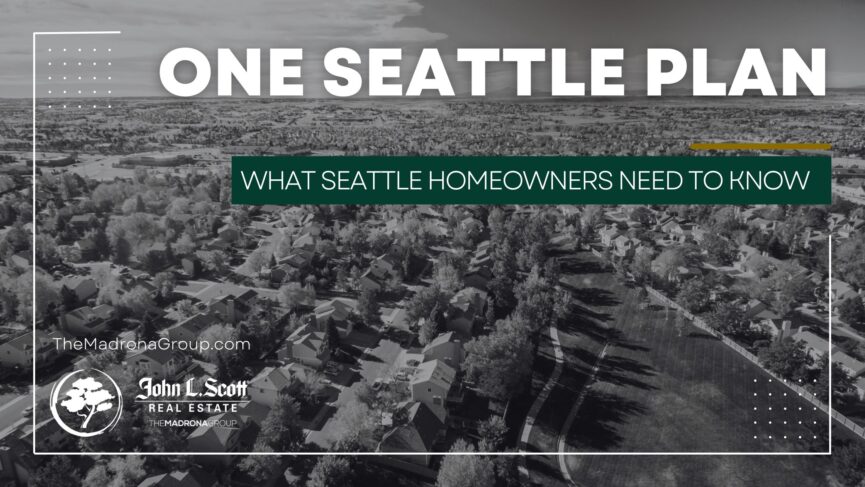“This plan represents a bold vision to create a more affordable, inclusive, and connected Seattle for the future.” — Seattle Office of Planning & Community Development
If you’re thinking about selling a home in Seattle or even just keeping an eye on the horizon, there’s a new citywide proposal you should know about: the One Seattle Plan. It’s not final yet—Seattle’s aiming for a June 2025 deadline—but this plan could shift how neighborhoods across the city look, feel, and function in the next couple decades. And if you’re a homeowner in King County or Snohomish County, this might just affect your home’s value and marketability down the line.
In this post, we’ll break it all down into plain English—because while the city documents are thorough, they’re not exactly light reading. We’re here to give you the need-to-know details from a Seattle real estate broker’s perspective.
What to Expect in This Article:
- What the One Seattle Plan is and why it matters
- How it might affect selling a home in Seattle
- Where zoning changes are most likely to occur
- What “missing middle housing” really means
- Key dates to watch (hint: June 2025 is a big one!)
- What Seattle homeowners should consider doing now
- Why The Madrona Group is watching this closely
What Is the One Seattle Plan?
The One Seattle Plan is the city’s latest draft of its Comprehensive Plan—essentially the roadmap that guides how Seattle will grow and change over the next 20 years. Think of it as Seattle’s long-range blueprint for managing housing, zoning, transportation, and development as we march toward a projected population of 1 million.
You can check out the city’s official materials here, but in a nutshell:
- It aims to expand housing options across all neighborhoods
- It wants to make room for more “middle housing”—like duplexes, triplexes, and small apartment buildings
- It emphasizes transit-oriented development near light rail and bus lines
- It focuses on equity and climate—ensuring the city grows in a way that supports all residents and is better for the planet
And just to reiterate—it’s not official yet. The final decisions will happen in mid-2025.
Why Should Homeowners Care?
If you’re thinking about selling a home in Seattle, especially in neighborhoods traditionally zoned for single-family use, the One Seattle Plan might be a game-changer. The city is proposing a set of zoning changes that could reshape what can be built on your property—and that has big implications for your home’s value and how potential buyers view it.
Here’s how:
Zoning Changes Could Increase Your Lot’s Value
Seattle is phasing out the old Single-Family (SF) zoning and introducing new designations that allow for “missing middle” housing across the city. This includes duplexes, triplexes, fourplexes—even small apartment-style buildings, depending on the location.
Under the draft plan, here are some of the new zoning codes you might see:
- NR1 (Neighborhood Residential 1) – Replaces traditional SF zoning. Allows up to 2 housing units per lot by default, with up to 4 if affordability requirements are met.
- NR2 (Neighborhood Residential 2) – A step up. Allows up to 4 units per lot, more if it’s near frequent transit.
- LR1, LR2, LR3 (Lowrise Residential) – These already exist but are expanding. Think townhomes, rowhouses, and small apartment buildings. The higher the number, the greater the allowed density and building height.
- MU (Mixed-Use) – Typically found near commercial corridors or transit hubs. Allows both residential and business use, often with higher density.
- HR (Highrise Residential) – Not likely for your typical homeowner lot, but these zones allow for mid-rise to high-rise buildings, mostly in urban centers.
If your home’s zoning moves from a former Single-Family designation to NR2 or LR1, suddenly your land could support more units—and that may mean more value. Developers, investors, and even extended families will be eyeing these lots with fresh interest.
What About “Highest and Best Use”?
One of the biggest real estate buzz phrases—highest and best use—really comes into play with the One Seattle Plan. This simply means the most profitable use of your property, based on what’s allowed by zoning. So, if your single-family lot could soon support a triplex or cottage cluster? Its highest and best use might be shifting, and that can make a big difference in how you price—or who you sell to.
Your Buyer Pool Might Change
With these new zoning codes, you might attract an entirely different type of buyer:
- Builders looking to create multi-unit developments
- Multi-generational families wanting to live close but not too close
- First-time buyers hoping to co-purchase and split a lot
This broader buyer pool could translate into more demand—and potentially better offers. But it could also mean a longer sales process if buyers are waiting for the final zoning map to shake out.
Timing Matters More Than Ever
We’re in a bit of a zoning limbo right now. The draft of the One Seattle Plan is out, and the final City Council vote is expected by June 2025.
That leaves sellers with some decisions:
- Wait and hope that your lot’s value climbs if it gets upzoned
- Sell now if you’re ready and don’t want to gamble on future changes
- Strategically list your home once the final zoning map is published and the new codes are confirmed
It all depends on your timeline and goals. But if your neighborhood is likely to shift from SF to NR2 or LR1? That’s something worth talking through with a knowledgeable local broker.g on the impact of Seattle zoning laws.
Where Will the Changes Happen?
Seattle’s looking to move away from its historic pattern of concentrating multi-family housing in a few zones and instead spread that growth across more neighborhoods.
Some of the zones expected to see the most change include:
- Areas near light rail and rapid transit hubs
- Traditionally single-family neighborhoods with large lots
- Sections of North Seattle, West Seattle, and Rainier Valley
It’s worth keeping an eye on how your neighborhood is categorized—especially if you’re in places like Ballard, Green Lake, Wallingford, or West Seattle, which are all areas under review.
What’s This “Missing Middle” Talk All About?
Missing middle housing is just a fancy way of describing homes that fall between single-family houses and big apartment buildings.
We’re talking about:
- Duplexes
- Triplexes
- Fourplexes
- Cottage clusters
- Townhomes
The One Seattle Plan proposes allowing these types of homes in every neighborhood—not just the ones already zoned for multi-family. That’s a big shift.
For Seattle sellers, this could mean your home is no longer just a single-family listing—it might be viewed as a potential site for multiple homes, giving it more long-term value.
Key Deadlines and Next Steps
- Spring 2024: Public input sessions and draft reviews underway
- May–June 2025: City Council votes on final version
- June 30, 2025: Deadline to comply with state planning laws
If you’re thinking of listing in 2024 or 2025, this timeline is important. Curious how long it takes to prep and sell a home in Seattle? We’ve covered that here.
What Homeowners Can Do Right Now
You don’t have to make a move just yet, but it’s a smart time to:
- Check your zoning. Use the city’s interactive map to see what’s proposed for your property.
- Schedule a valuation. Find out your current market value—and how it might change with the One Seattle Plan. Start with our 5-minute site price consultation.
- Talk with a Seattle real estate broker who understands how policy shifts impact pricing and timing.
The Madrona Group Is Watching This Closely
As brokers at The Madrona Group with John L. Scott, we’re keeping tabs on this plan not just because it’s big news—but because it’s going to shape how we help our clients list, price, and market their homes in the coming years.
Whether you’re thinking about selling in Seattle, Snohomish County, or anywhere in King County, we’re ready to walk you through your options—no jargon, no pressure, just real-world info you can use.
Final Thoughts on the One Seattle Plan
The One Seattle Plan is more than a city document—it’s a glimpse into what Seattle could become. If you’re a homeowner, especially one considering selling in the next few years, now’s the time to start thinking about how this could affect you. From zoning changes to new buyer interest, your property’s appeal might look different a year or two from now.
But here’s the good news: you don’t have to figure it out alone. Having a knowledgeable, friendly Seattle real estate broker on your side can make all the difference. The Madrona Group is already working with homeowners just like you who want to understand their home’s potential in light of these changes—and make smart moves, not rushed ones.
FAQs: One Seattle Plan
What is the One Seattle Plan?
It’s the city’s updated Comprehensive Plan, laying out how Seattle will grow and change over the next 20 years—especially around housing and zoning.
When will the One Seattle Plan be finalized?
City Council votes are expected in May or June 2025, with a state deadline of June 30, 2025.
Could this plan affect my home value?
Yes—especially if zoning changes allow more housing types on your property, which could increase market value or broaden your buyer pool.
How do I know if my property is affected?
Use the city’s zoning map, or schedule a consultation with a local real estate broker.
Should I wait to sell my house?
It depends on your goals and timeline. A broker can help you weigh your options based on your specific property and the timing of the plan.
Takeaways
- The One Seattle Plan is set to reshape housing and zoning citywide.
- Sellers in single-family zones could see more options or buyer interest soon.
- Final votes are expected by June 2025—so now’s the time to plan ahead.
- Get your home evaluated to understand how it fits into the city’s big vision.
Share this post!




